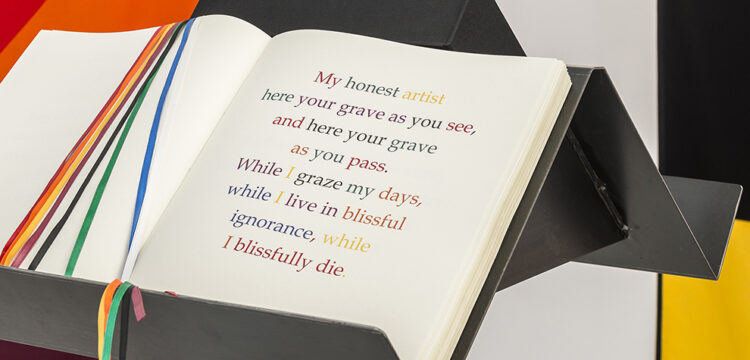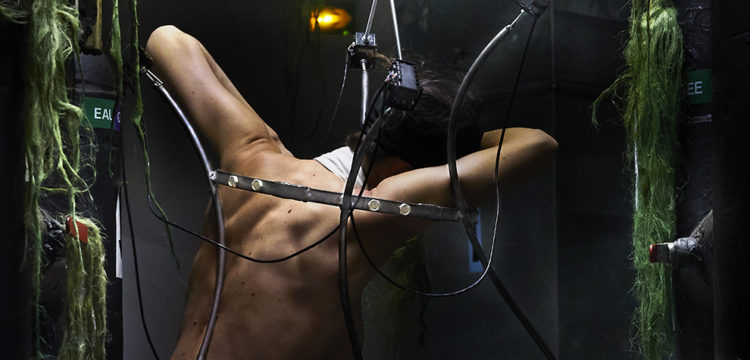Object Oriented Choreography
Reading suggestions toward a lecture-performance suspended between the real and the virtual
Winner of the second edition of RE: Humanism Art Prize, Francesco Luzzana constructs a performance suspended between the real and the virtual. Presented at Romaeuropa Festival, Object Oriented Choreography is a collaborative performance in which the audience and performer try to impersonate and empathize with contemporary digital platforms, with particular attention to their relational and logistic aspects. Through a combined effort of imagination, listening and direct involvement, the audience and the performers participate in OOC in a process of empathy with the non-human identified, in what Luzzana defines as “the zone”.
Welcome to this iteration of Object Oriented Choreography—a performative essay and collective reading. By combining this text with the movements of a dancer, we intend to explore digital information with different kinds of intelligence—that of the word and that of the body. Together we will inhabit contemporary complexity as well as investigate some of its contradictions.
If you want to participate in the upcoming performances, please arrive with a smartphone or a tablet. The ideal fruition of the show requires the audience to read the essay along with the performance. Take your time, and do not worry if something seems to slip away from the corner of your eyes. Your attention is something precious and we would like it to sway from your smartphone to the dancer, to the other guests and back again.
If you are reading this in advance, make sure to return here on o-o-c.org when the performance starts. Before the show begins, please check your internet connection. If your device has no signal, a wi-fi network is available at the location.
This website puts accessibility first. From the settings icon at the top-left corner, you can switch between dark and light color themes, as well as change the settings of the text to read it better. Feel free to write to us if you find something too difficult to manage or just want to leave feedback.
During your reading you will find some interactive keywords. Try to tap on them and see what happens. Bear in mind that the other participants are also reading, so watch out for their presence throughout the essay. Keep your eyes open and let your attention dance!
Click here to check if the performer is online.
0. The Zone
Everything revolves around the zone. Getting in does not require a Tarkovskian loner to show you the way. As soon as your face unlocks the phone you are there. Time is stretched. The zone is activated and stimulated by your fingertips. Hypertexts enfold. A mirror of self.
The zone is an apparatus composed of people, objects, digital platforms, electromagnetic fields, spaces, and rhythms. An accidental interlocking of logics and logistics, dynamics and rules that allow it to exist, to evolve, and eventually to disappear once the premises that made it possible come undone.
The zone could be an almost fully automated Amazon warehouse as well as the network of shared scooters scattered around the city. It could be a group of riders waiting for orders outside your favorite take-away, or a TikTok house and its followers.
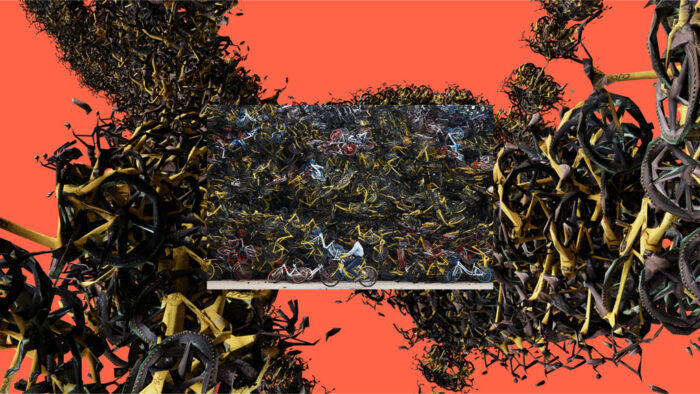
The scattering of shared bikes in a 3D environment is not so different from their scattering in the real world.
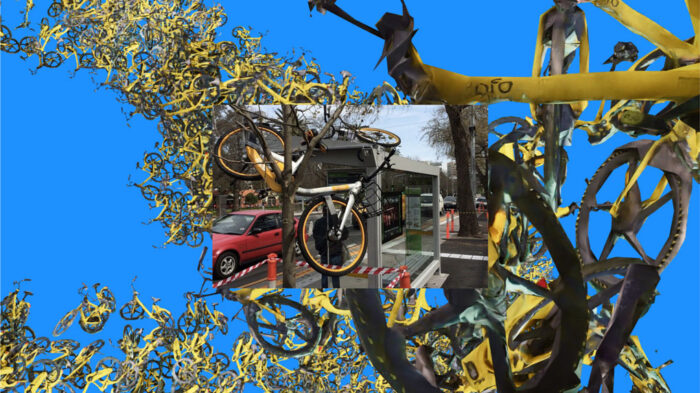
Yet the real world still has some bugs.
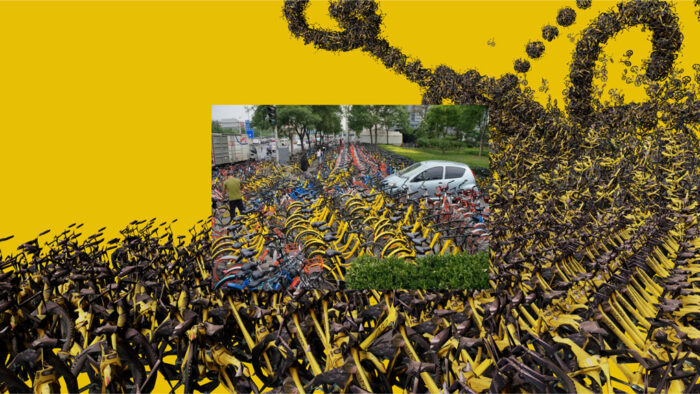
The same 3D model is being ctrl+c ctrl+v ctrl+v ctrl+v to ridiculous amounts
A new memento mori: all hypes come to a dead end.
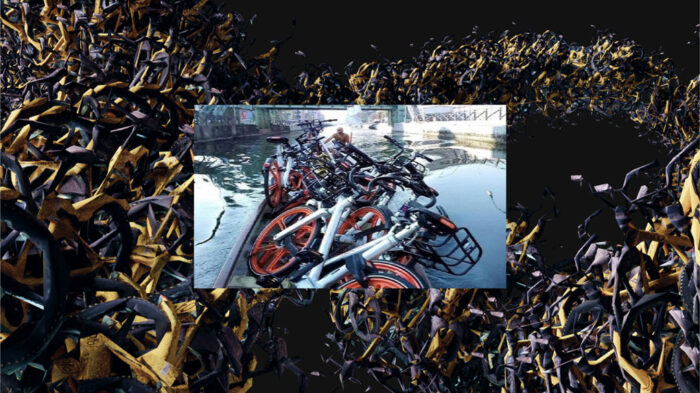
Digital Charon ferrying lost bikes on the river.
What are the borders of the zone? What consistency does its reality have? Many replaced the physicality of the zone with a mood, a state of mind. Being in the zone. A condition of full immersion: a deep focus and total engagement.
This condition of immersiveness affects our perception and understanding of the world. How can we intervene beyond the limits it imposes on us?
Through a combined effort of imagining, listening, and direct involvement, we participate in a process of empathy with the non-human. How does the zone feel and how do we feel the zone? How does the zone perceive and inhabit the world?
1. Problems of scale in time and space
We are tapping and scrolling on quartz screens. As a matter of fact, we are scrolling right now. Unknowingly or not, fingers are gliding on a smooth surface. The feeling is similar to that of gliding our fingers on the bathroom mirror after a shower. The purpose however changes: from drawing a scribble to following icons. The same gesture—of removing water particles from a mirror looking back at you—is now suddenly chasing the information that the mirror is hiding.
This information:
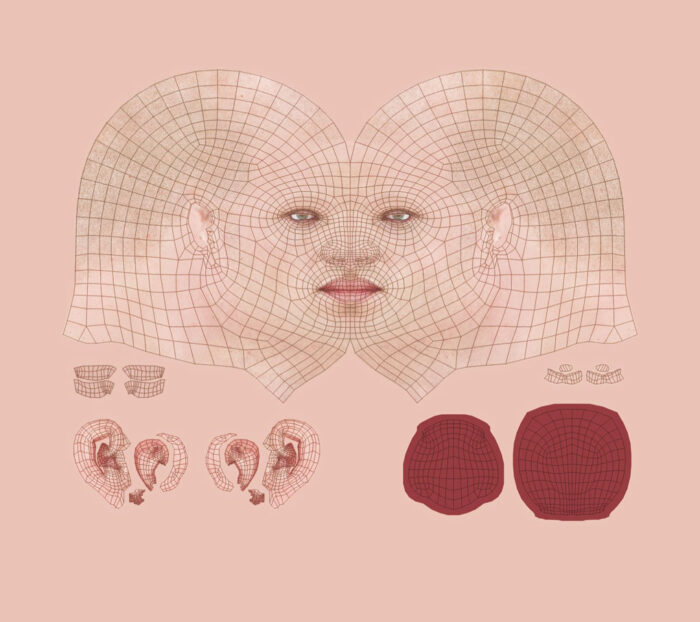
The skin is human’s largest organ.
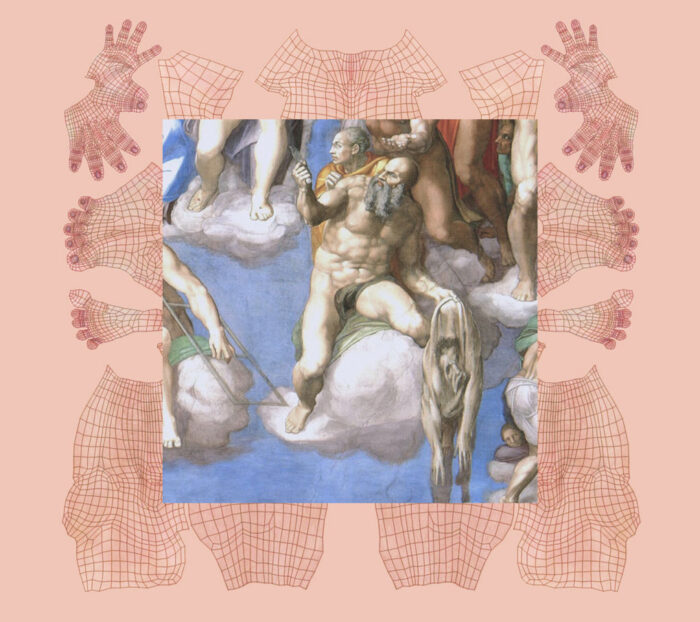
It is prone to the most violence
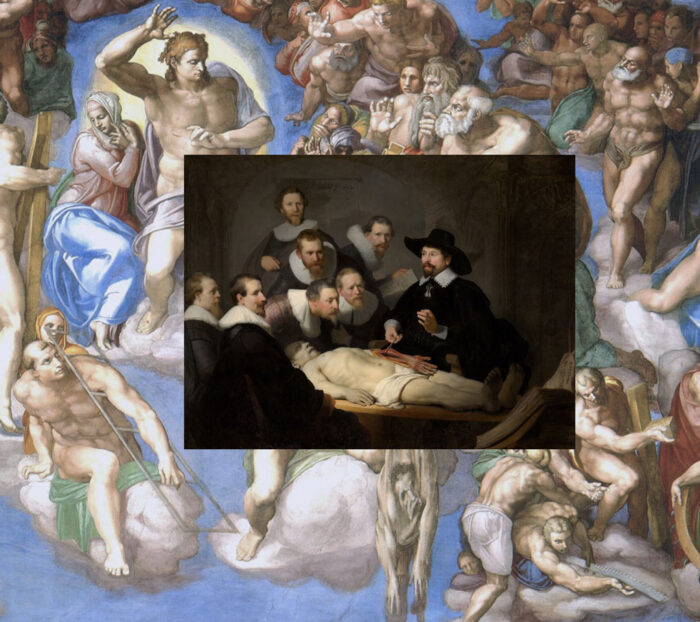
It conceals our hidden mystery
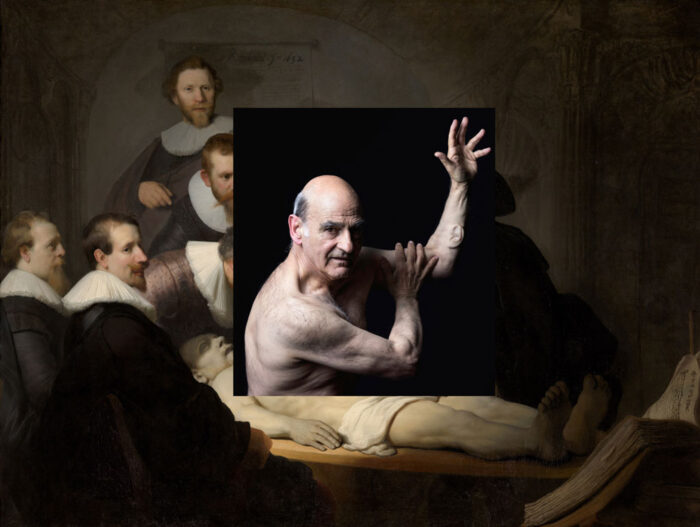
And it is a platform for expanding the self
A living surface extends nimble limbs to its surroundings. Touching, feeling, and receiving. Millions of cells with the purpose of bringing home information. To make the surroundings true. The palpable begets the real. The real begets personal truths.
But we are not the only ones to sense. Now the artificial surface is sensing too. It modulates human touch. It mediates, enables and engenders connections.
The touchscreen ambushes our thumbs. Inputs finish their journey on the glass surface, after passing their legacy to the software that carries on their meaning. But what if we could deliver these inputs even further, instead of just landing them on the display? Can we imagine touch as a form of presence, or even as a form of proximity? How can we depict the user’s affection to the program, to the interface, and in this case, to the performer?

Now the surface is sensing too.
Is touchscreen our visual take
on sensing reality from a distance?
Digital technologies amplify the velocity and extent of information. Such amplification scales information to sizes that exceed perception. High frequencies are invisible to the human eye and thought, however we must not let them bug our instincts.
The common ground between digitalities and the body could be used as a platform for developing intuition strategies. These interfaces might give space to new trajectories where senses cannot reach.
To better understand their potential, we must focus on the crossway between how the zone feels and how we feel the zone.
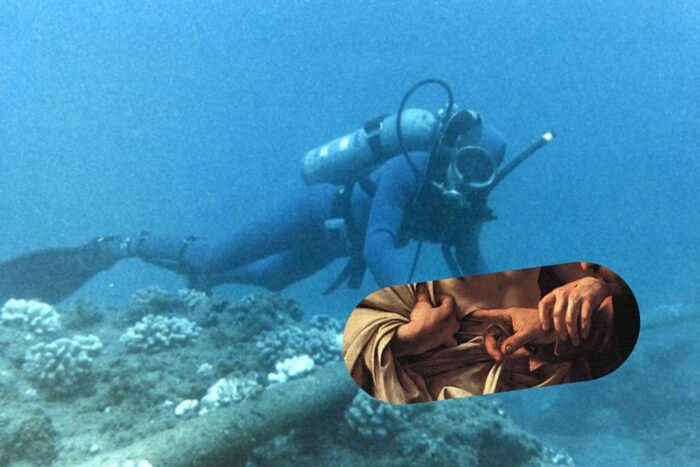
A scuba-diver touches the internet.
What if @StThomas, the Apostle well known for his doubt, actually believed from the very beginning in the resurrection of Christ and only touched to better grasp the divine being? What he did was not an act of incredulity, but an empirical experience of God through its physical interface.
The experience of @StThomas is a direct confrontation with Christ, one that overcomes the mediation of language or sight. A core concept here is the body’s ability to approach the world via forms that do not completely overlap with logical-verbal reasoning.
Between 2015 and 2016, artist Trevor Paglen took different dives to the bottom of the ocean to find the submarine communication cables that permit our global networking. These cables are the evolution of those laid for telegraph communications centuries ago and underline the very physical nature of the Internet that is too often overlooked.
Here, Paglen’s immersion can be seen as an extension of the doubt of Saint Thomas into the digital age. The intangible field of wi-fi signals is replaced by the force of water pressure. This acts on the body as a dangerous sheath, shaping both movements and thoughts, surrounding, and winding the mind in its streams.
Phenomenological Bermuda Triangle:
Eye of fire after underwater gas leak in Gulf of Mexico
2. Problems of multitude and quantity
The digital system is not a static configuration, but rather a developing knot of relations between technologies. Each configuration is forked, altered, and merged. Each arrangement enters the stage: sometimes denying the previous one, sometimes coexisting with it, and sometimes both. An ever-changing choreography that follows its own erratic pattern.
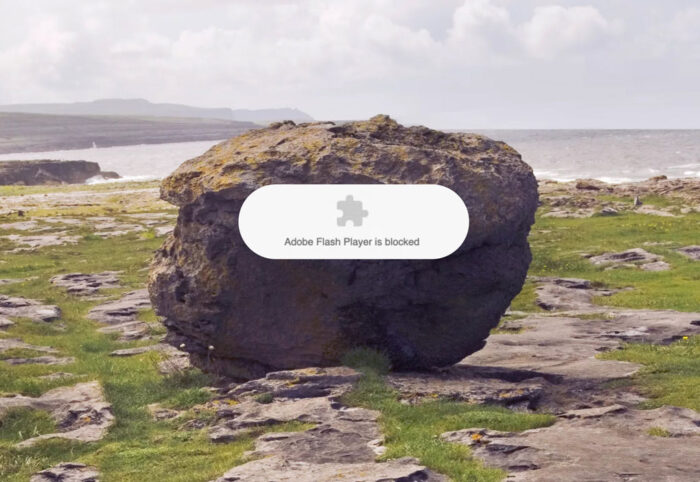
The slow digital melting causes technology to be found in rather unexpected places: when Adobe dismissed Flash, it also stopped an entire Chinese railroad.
The zone seems to turn its back on rationality. Its super-expansion advances configurations which are contradictory and counterintuitive. Formal logic cannot hold on to X and NOT X at the same time, yet the zone can. In doing so, it undermines our attempts to access it through a rational approach and with a fixed bag of beliefs.
We are embodying a divergent condition that is gradually shapeshifting us into a weird state of being. A contemporary version of Janus, the Roman god with two faces, learning to cope with such a thriving, incongruent multiplicity. Our thoughts cannot grasp all the layered hierarchies of these mutable links. We can only make sense of our first-hand experience, while all the rest sneaks by, even in plain sight.
Accessing the zone opens a path across our technical configuration, our physical displacement, and our everyday lives. On this trajectory bizarre encounters happen.
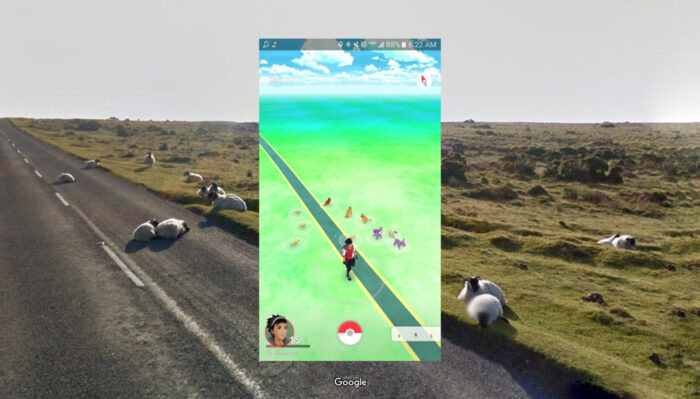
Google Sheep waiting for their virtual shepherd.
Despite everyone’s own personal journey, the zone blurs the limits between different personalities fostering quantity over identity. There is no mediation between the routes that we trace. The zone seems to only focus on single layers, and not on the movements at work between them. It ties users up in their rendezvous, further entangling their passage, dampening away their empathy.
The two faces of Janus looking in specular directions—the past and the future, the inside and the outside—were historically set on many arcs and doors to look over passageways. In the context of the zone, Janus becomes the god of transitioning through the infrastructure, a protector of all the volatile bodies that wander through its layers: from gig economy riders to social media moderators. Maybe, during our wanderings, we could also take shelter under his protection. By treasuring his dual perspective we can better focus on our trajectories.
Ready-to-3D-print Janus as your personal divine iPhone cover
3. Problems of Efficiency and Violence
Inhabiting the zone, and aiming to approach its physical and intellectual challenges does not manage to deal completely with the moral and ethical issues that its nature arises. Sometimes a single direction prevails among the others. Efficiency implies the violent imposition of the shortest path by establishing its inertial force.
In order to achieve efficiency, the zone evens out the creases of its complexity with the weight of its infrastructure. The cruelty of its footprint overwhelms the same bodies that support and keep it moving forward. By exploiting the unprotected, it ensures the supposedly consistent functioning of its gears.
The flap of the butterfly wing has now been condensed into the tap of the finger. The hypothetical typhoon is now a confirmed order placed online and its imminent journey from an undisclosed warehouse to your doorstep.
We can finally perceive the instability of this massive system. We can now feel the friction of the endless scroll.
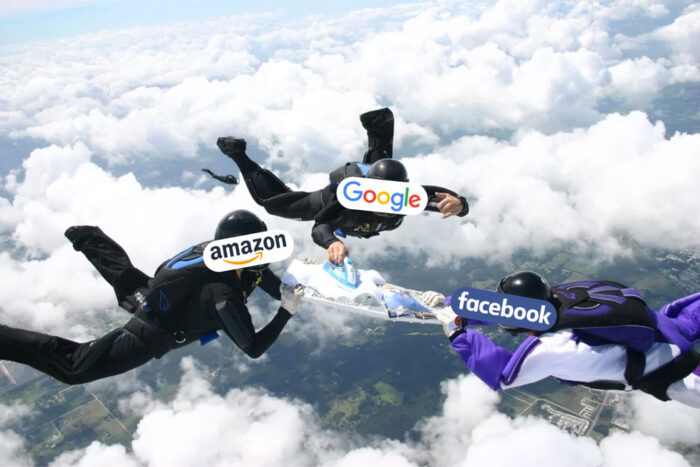
Extreme ironing: the zone evens out the creases of its complexity
with the weight of its infrastructure.
Shifting the pivot from a logical intelligence to a material one—especially a corporal one—could provide us with cognitive structures better suited to grasp the multi-dimensional complexity of the zone.
Hence this concerted reading. A way to bring a multitude together. A text that displaces our bodies. Makes them dance, makes them halt. A collective ritual of imagining and listening, of gathering knowledge and accessing information. A process of empathy with other users and their journeys through the zone.
The Zone
Is unknown performance.
Is an emanation of the moving now.
Is a dance of power structures.
Is a ceaseless choreography at the interface.
The Zone
Is rhythm and density.
Is smooth scroll and buffering.
Is fingerprint run amok.
Is tangible truth.
The Zone
Proliferates between nodes.
Thrives on precarious infrastructure and frameworks.
Transforms flat gestures to global actions.
Affects clouds, oceans and highways.
The Zone
Is as rigid as it is flexible.
Is as ephemeral as it is permanent.
Is as real as it is virtual.
Is as past as it is present and future.
The Zone
Is the Z in Zoom.
Is the Z in Zuckerberg.
Is the Z in Amazon.
Is whatever your movement tells it to be.
Thank you for reading and participating. You can keep on interacting with the performer by scrolling freely through the essay. When you are done, you can Log Out.
This text has been composed in collaboration with Iulia Radu and Stefano Togni.



